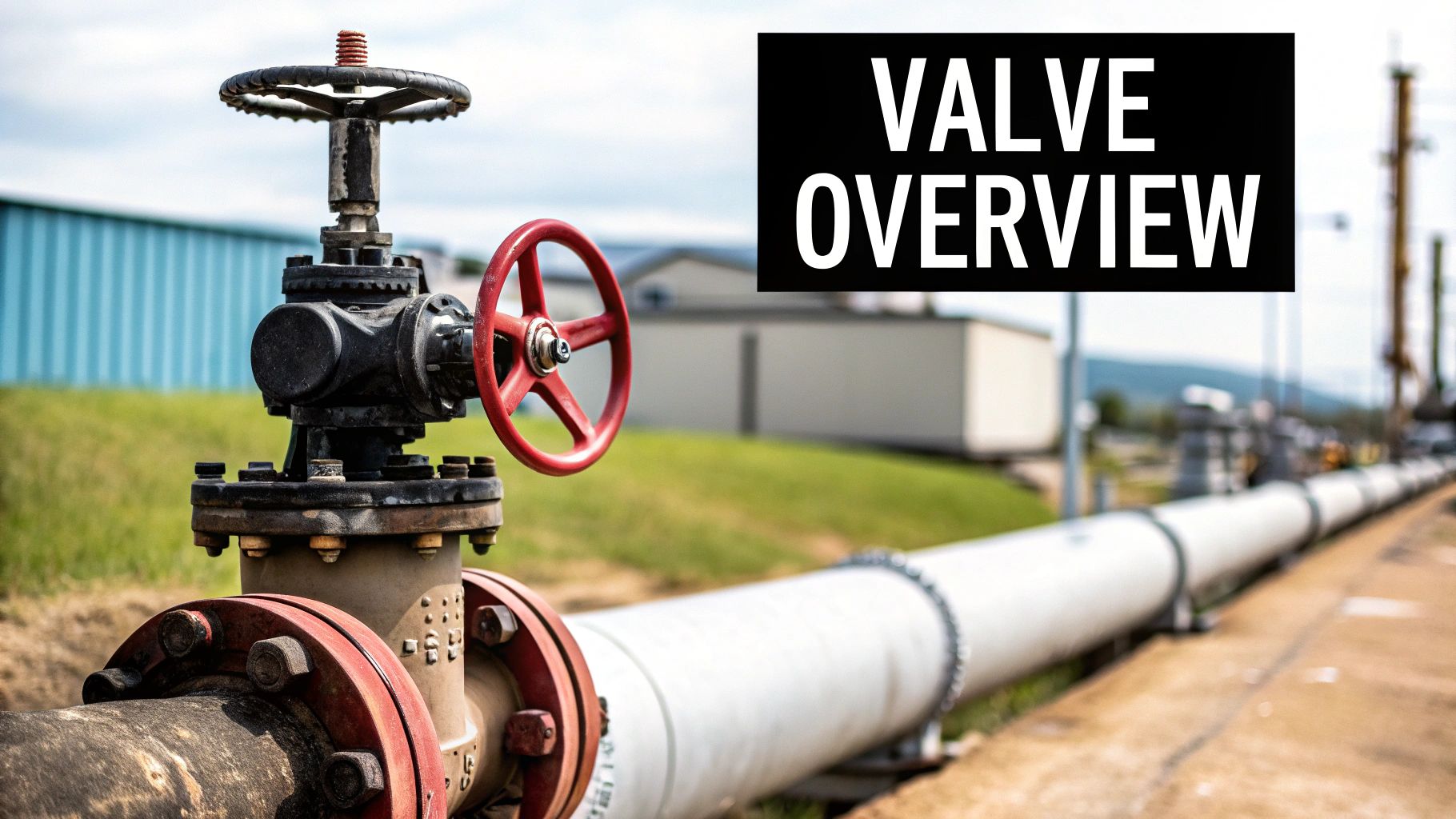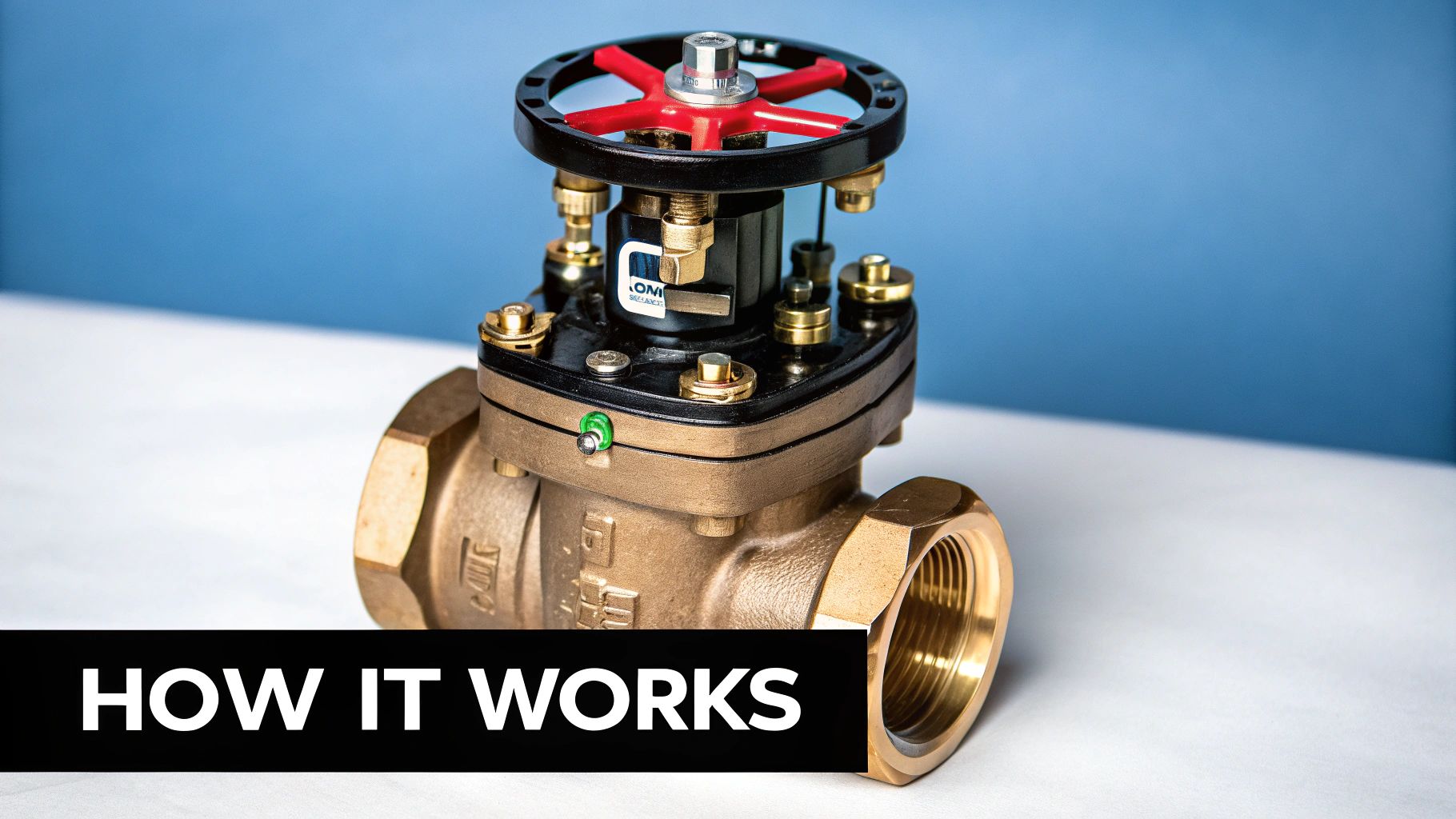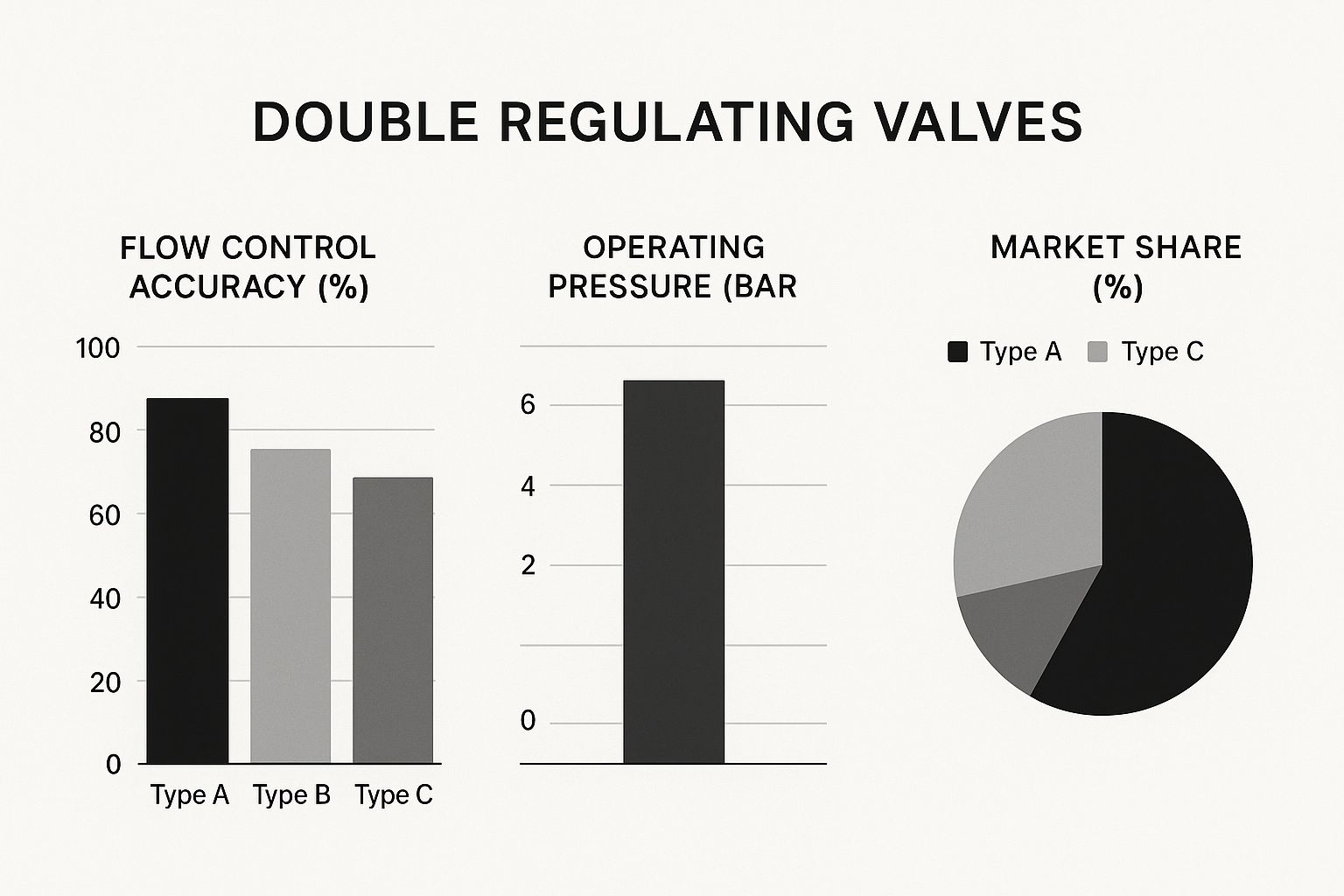Double Regulating Valve UK: Expert HVAC Control Solutions
Understanding Double Regulating Valves In UK Systems

Double regulating valves are becoming increasingly popular in UK heating systems. Experienced engineers often prefer them for their precise control and balancing of water flow. This precision leads to better efficiency and overall system performance. But what makes these valves different from standard regulating valves? Let's explore the engineering behind these important components.
One key feature is the ability to create precise flow resistance within bypass circuits. This ensures consistent water flow, preventing imbalances and optimizing heat distribution. Imagine a large building with multiple heating zones. Double regulating valves ensure each zone receives the correct amount of hot water, regardless of fluctuating demand.
This consistent delivery results in stable temperatures and improved energy efficiency. It also simplifies the process of balancing the system, ensuring optimal performance from the start. This precise control is a major advantage in complex heating systems.
The Variable Orifice Double Regulating Valve (VODRV) represents a significant advancement. VODRVs offer exceptional control over flow rates, making them perfect for commissioning and fine-tuning systems. This level of precision is essential for modern installations with complex pipework and varying heating demands.
Historically, the development of control valves, including double regulating valves, has been driven by innovation. In the UK, these valves are primarily used in heating systems for creating flow resistance or pressure drops in bypass circuits. The VODRV, a type of double regulating valve, is often used as a commissioning valve due to its ability to precisely regulate flow rates. Learn more about double regulating valves.
Practical Applications In UK Heating Systems
Successful projects across the UK highlight the impact of proper valve selection on system performance. From homes to large commercial buildings, these valves play a key role in optimizing energy use and ensuring long-term system reliability. The right valve choice also simplifies commissioning and maintenance.
Consider a commercial building in London with a large heating network. Using double regulating valves allows engineers to precisely balance flow rates to each area, ensuring even heating throughout the building. This results in increased occupant comfort and reduced energy waste. How to master vacuum solenoid valves.
These precise controls are crucial for maintaining a comfortable and efficient environment in complex systems. The underlying engineering principles make double regulating valves essential for critical heating applications throughout the UK. Proper valve selection contributes to a more efficient, reliable, and comfortable heating system.
Navigating Commissioning Costs And Implementation Challenges

While double regulating valves offer significant advantages for flow control in UK heating systems, understanding the associated commissioning costs and implementation challenges is crucial. This knowledge allows for effective budgeting and thorough project planning. It's important to note that installation costs can sometimes surpass the initial purchase price of the valve itself.
Understanding the Complexity of Flow Rate Setting
The intricacies of achieving precise flow rates contribute significantly to higher commissioning costs. Accurate flow setting involves calculating the Kv value for each handwheel setting, as well as determining the pressure drop across the valve. This process is similar to calibrating a sensitive instrument, requiring time, expertise, and specialized tools.
This meticulous procedure can be time-consuming and potentially lead to measurement inaccuracies. Inaccuracies can reach up to 15% when operating near the minimum set point. While the initial purchase cost might be lower, the commissioning cost can be substantially higher due to the process complexity. Discover more insights about double regulating valves.
Real-World Challenges in UK Installations
Many UK installations exemplify these challenges. Balancing flow within multi-zone systems in older buildings, for instance, can be particularly difficult. Variations in pipe sizes and existing system layouts often introduce unanticipated complexities. When facing commissioning challenges in specific UK regions, understanding local expertise can be beneficial. For example, situations may arise where specialized services, like those of a private investigator in Coventry, are required.
Minimizing Commissioning Time and Maintaining Precision
How can you minimize commissioning time while ensuring accuracy? Careful planning and engaging experienced engineers familiar with double regulating valves are essential.
Furthermore, using advanced measuring equipment can greatly improve accuracy and reduce commissioning time. This proactive approach ultimately saves both time and money. By recognizing the commissioning costs and complexities of double regulating valves, engineers can ensure successful implementation and optimal performance within UK heating systems. This ensures efficient and effective system operation for years to come.
Technical Specifications And Smart Sizing Strategies
Selecting the right double regulating valve depends on understanding the technical specifications that impact your system's performance. Available bore sizes in the UK range from 15mm for compact residential systems to 200mm for large commercial projects. This wide range ensures a suitable valve for almost any application.
Manual Operation and Locking Mechanisms
Most double regulating valves use a manually operated handwheel system. This handwheel adjusts the valve's internal components to control flow. Locking devices are essential for maintaining specific settings, preventing accidental adjustments, and ensuring consistent performance. These locking features are especially important in environments with vibrations or potential accidental contact.
Temperature and Application Considerations
Double regulating valves are categorized by temperature classifications, including high, medium, and low temperature hot water systems, as well as cold water applications. Choosing the correct valve type for the application is crucial. Using a high-temperature valve in a low-temperature system, for example, could lead to inefficiency and premature wear. Double regulating valves are essential for balancing and commissioning heating systems across the UK in these various temperature applications. Suppliers like Peter Smith Valves offer a range of sizes to meet diverse industrial needs.

The infographic above illustrates flow control accuracy, operating pressure ranges, and market share for three types of double regulating valves (Type A, B, and C). Type A valves offer the highest flow control accuracy but have a smaller market share than Type B, which balances accuracy and market presence. Type C, with the lowest accuracy, holds a significant market share, likely due to factors like cost-effectiveness. For more information on related valve types, check out this resource on pressure reducing valves.
The following table provides a comparison of double regulating valve specifications. This information is crucial for selecting the right valve for your specific heating system requirements.
Double Regulating Valve Specifications Comparison Comparison of key technical specifications including bore sizes, temperature ratings, and application suitability for different UK heating systems
| Bore Size (mm) | Temperature Rating | Application Type | Flow Range | Pressure Rating |
|---|---|---|---|---|
| 15 | Low | Residential Heating | 0.5 - 2 GPM | 10 bar |
| 22 | Medium | Underfloor Heating | 1 - 5 GPM | 16 bar |
| 28 | High | Commercial Heating | 2 - 10 GPM | 20 bar |
| 42 | Medium | District Heating | 5 - 20 GPM | 16 bar |
| 54 | High | Industrial Heating | 10 - 40 GPM | 25 bar |
Note: This table presents example data and may not reflect specific product specifications. Consult manufacturer datasheets for accurate details.
As shown in the table, different bore sizes cater to varying temperature ratings and flow requirements. Selecting the appropriate bore size is essential for optimal system performance.
Practical Sizing Strategies
Choosing the correct bore size is essential for optimal performance. An undersized valve restricts flow, while an oversized valve might not provide precise control. Factors such as pipe diameter, system pressure, and the desired flow rate influence sizing decisions. By carefully considering these specifications, you can ensure your double regulating valve delivers efficient and reliable performance for years to come in your UK installation. This detailed approach is key, especially in demanding applications.
Installation Excellence For UK Heating Applications
Successful double regulating valve installation hinges on adhering to UK building standards and employing best engineering practices. This ensures both immediate and long-term performance. This section provides practical, step-by-step guidance for correct valve placement, pipework integration, and effective system integration.
Valve Positioning and Pipework Considerations
Proper valve orientation is crucial for accurate flow measurement and long-term reliability. Installing a double regulating valve incorrectly can lead to inaccurate readings and premature wear. Think of a water meter installed upside down; it simply won't measure accurately. A misaligned double regulating valve will similarly compromise performance.
The valve should be installed in the correct flow direction, clearly indicated on the valve body. Also, ensure sufficient straight pipe sections both upstream and downstream of the valve. This promotes stable flow conditions, improving measurement accuracy. These straight sections act as a smooth pathway for the water, ensuring consistent flow before and after the valve.
- Key Installation Steps:
- Isolate the section of the heating system where the valve will be installed.
- Clean the pipework to remove any debris.
- Ensure the valve is oriented in the correct flow direction.
- Use the correct pipe sealant for the specific pipe material.
- Securely connect the valve to the pipework using appropriate methods.
System Integration and Best Practices
Integrating double regulating valves into existing heating circuits requires careful planning. Understanding thermal expansion is crucial, especially in larger systems. Pipework, like railway tracks, expands and contracts with temperature changes. Accommodating this movement prevents stress on the valve and ensures long-term reliability.
Easy maintenance access is another key factor. Servicing a component without access is impossible. The double regulating valve must be accessible for future maintenance and adjustments.
Reviewing case studies from successful UK installations can offer valuable insights. These real-world examples demonstrate effective integration strategies for different system types and configurations, providing practical, applicable knowledge.
Material-Specific Tips for UK Heating Systems
Different pipe materials require different connection methods. Copper pipe, common in UK heating systems, requires specific soldering techniques. Plastic pipework, on the other hand, utilizes methods like push-fit or compression fittings. Using the incorrect method can lead to leaks and other problems.
- Tips for Different Pipe Materials:
- Copper: Ensure clean surfaces for soldering and use flux to improve the solder joint.
- Plastic: Ensure proper pipe insertion depth for push-fit connections and use a calibrated torque wrench for compression fittings.
- Steel: Ensure proper threading and use appropriate sealant for threaded connections.
By following these guidelines and consulting with experienced engineers, you can ensure a professional double regulating valve installation. This focus on installation excellence contributes to a reliable, efficient heating system, providing long-term benefits. Proper installation is the cornerstone of maximizing the effectiveness of a double regulating valve.
Performance Optimization And Advanced Flow Control

Maximizing the performance of a double regulating valve hinges on understanding advanced flow control strategies. These strategies should deliver tangible improvements to overall system efficiency, a particularly important consideration for efficient heating in the UK. We'll explore achieving precise flow balancing in the complex heating circuits, including multi-zone systems, often found in UK commercial buildings. During installation, referring to a comprehensive electrical inspection checklist is always recommended.
Utilizing Modern Measurement Tools
Modern measurement tools significantly improve the accuracy of commissioning a double regulating valve. These tools provide engineers with real-time data, allowing for fine-tuning and optimal performance.
Digital pressure gauges and flow meters offer precise measurements, replacing older, less accurate methods. This precision is crucial for achieving the desired flow balance within the system. The improved accuracy translates to better system performance and lower energy consumption.
Dynamic Balancing Techniques
Maintaining consistent performance requires dynamic balancing techniques. These techniques adapt to changes in system demand, ensuring consistent flow rates. Think of it like a car's cruise control: it automatically adjusts to maintain a set speed regardless of the terrain.
Similarly, dynamic balancing adjusts the double regulating valve to maintain the target flow rate, even with fluctuating heating demands. This ensures consistent performance and optimizes energy efficiency.
Effective Maintenance and Performance Monitoring
A proactive maintenance schedule is crucial for the long-term reliability and performance of a double regulating valve. Regular inspections and maintenance can identify and address potential issues before they become major problems, much like regular car maintenance prevents larger, more expensive repairs.
Performance monitoring is also vital for ongoing optimization. Monitoring key indicators, like pressure drop and flow rate, provides valuable data for identifying performance deviations. This allows for timely adjustments and ensures continued efficient operation.
To help illustrate these strategies, the table below summarizes key performance indicators and optimization techniques.
Performance Optimization Strategies
| Strategy | Implementation Method | Expected Improvement | Monitoring Frequency |
|---|---|---|---|
| Dynamic Balancing | Automated adjustments based on system demand | Consistent flow rates despite fluctuations | Continuous |
| Preventative Maintenance | Regular inspections and cleaning | Reduced risk of component failure | Monthly/Quarterly |
| Flow Measurement & Adjustment | Using digital flow meters and pressure gauges | Optimized flow balance and reduced energy consumption | During commissioning and annually |
This table highlights the importance of a multifaceted approach to maintaining optimal performance. By combining dynamic balancing with regular maintenance and precise flow measurement, significant improvements can be achieved.
Practical Troubleshooting and Preventive Maintenance
Common performance issues with double regulating valves can often be resolved through practical troubleshooting. Checking for debris or blockages in the valve, for instance, can often restore proper function.
Implementing preventive maintenance programs extends the valve's lifespan and improves system reliability. This proactive approach minimizes downtime and ensures smooth heating system operation.
Performance optimization for double regulating valves necessitates a comprehensive approach. Using modern tools, implementing dynamic balancing, and adhering to a proactive maintenance schedule allows engineers to maximize valve performance. This, in turn, contributes to energy efficiency and occupant comfort in UK buildings, ensuring that heating systems operate at peak performance and deliver the desired comfort and efficiency.
Market Evolution And Technology Developments
The UK market for double regulating valves is changing. Evolving building regulations and a growing focus on sustainability are driving forces behind how engineers choose and use valves. Staying up-to-date on market dynamics and predicted growth is crucial.
Current Market Dynamics and Growth
Demand for double regulating valves is increasing in the UK. This growth is due to factors such as stricter energy efficiency standards and increasingly complex heating systems. These trends influence not just valve selection, but overall system design. They also lead to opportunities for innovation in flow control technologies. Market analysis predicts continued expansion in the coming years. From 2019 to 2033, double regulating valves are expected to see significant growth, showing a CAGR increase. The period from 2019 to 2024 serves as the basis for projections from 2025 to 2033. Explore this topic further.
Technological Advancements in Valve Design
Technology is boosting the performance of double regulating valves. Better materials and manufacturing techniques are leading to increased durability and precision. This enhanced precision allows for finer control over flow rates, improving system efficiency.
Some newer valves even incorporate smart technology, integrating with Building Management Systems. This provides more control and monitoring, further optimizing systems.
Emerging Trends in Flow Control Technology
Emerging trends like the Internet of Things (IoT) and data analytics are shaping the future of valve technology. Collecting and analyzing performance data unlocks the potential for predictive maintenance and even greater system optimization.
This data-driven approach lets engineers address potential problems before they escalate, minimizing downtime and maintenance expenses. As technology progresses, expect more integration of smart features and advanced control algorithms within double regulating valves. These advancements will further refine flow control and boost the efficiency of UK heating systems, supporting a more sustainable future.
Key Takeaways And Selection Framework
Making the right double regulating valve choice involves balancing technical specifications with budget constraints and desired long-term performance. This framework summarizes key selection criteria—sizing, materials, and application suitability—for successful projects in the UK.
Essential Selection Criteria
Choosing a double regulating valve requires a systematic approach. Start by accurately calculating the required bore size. Consider the pipe diameter, system pressure, and the desired flow rate. This ensures the valve can handle the system's demands without restriction or loss of control. You might be interested in: How to master valve selection.
Next, evaluate material specifications. Ensure the valve's material is compatible with the system's fluid and operating temperature. This prevents corrosion and ensures long-term reliability. For instance, stainless steel valves are often suitable for harsh environments, whereas brass might suffice for less demanding applications.
Finally, consider application suitability. Different valve types are designed for specific applications. A valve designed for high-temperature hot water systems isn't suitable for a cold-water application. Matching the valve to its intended application ensures optimal performance.
Evaluating Valve Options and Total Cost of Ownership
When evaluating options, look beyond the initial purchase price. Consider the total cost of ownership, including installation, commissioning, and ongoing maintenance expenses. While one valve may have a lower upfront cost, its complex commissioning process could significantly increase overall expenses.
- Checklist for Evaluating Valve Options:
- Bore size and flow capacity
- Material compatibility with system fluids
- Temperature rating
- Pressure rating
- Installation and commissioning requirements
- Maintenance requirements
This checklist helps compare different valves and make informed decisions based on your specific project needs.
Key Performance Indicators and Maintenance
Monitoring key performance indicators (KPIs) ensures reliable operation. Track the pressure drop across the valve and the flow rate to identify potential issues early. This proactive approach allows for timely maintenance and prevents costly downtime.
Regular maintenance, including cleaning and inspection, extends the valve's service life. A well-maintained valve operates more efficiently and reliably, contributing to optimal overall system performance.
Explore our comprehensive range of double regulating valves designed for the demanding requirements of UK heating applications at Solenoid Valve World. Our expert team can assist you in selecting the perfect valve for your specific needs.
